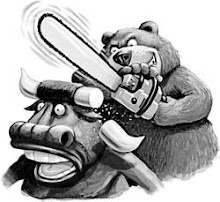Bullish 4th Quarter? Negative Scenario
Previous posts "Bullish 4th Quarter Part 1" "Part 2" and "Part 3" discussed the need for the final quarter of 2009 to reach a certain level on the SPX or else the highly leveraged system would not have sufficient equity to maintain itself. In this posting, I would like to introduce a bearish scenario based on the assumption that the financial system has been critically damaged and that due to the high level of global indebtedness, it is prone, if not bound, to fail. This failure could be imminent and unavoidable in spite of (or more accurately due to) interventions by governments around the globe to prop up a fatally flawed financial system. Events of the last 12 months have heightened the risks at the very time that most mainstream observers and participants believe that the "worst is past". But the imbalances in the global financial "system" are now even greater and more unwieldy. It is impossible to know what catalyst will cause another, more damaging crisis, whether it will be Eastern European debt default, a Chinese economic collapse, an Australian bust or some other event presently off the radar. But with the underlying problems of over-indebtedness and unsustainable capital flows remaining unaddressed and even exacerbated, world equity markets at levels 50-60% above lows reached earlier this very year have created even greater risk of calamity. So I have attempted to map out a possible scenario which could occur in case of a global accident, which I believe is very likely to occur. The attached quarterly chart of the Dow Industrials is entirely speculative and presented simply of an examination of what is possible. There are numerous variables, that could affect the outcome, but I believe that some version of the following is likely if the SPX is not able to maintain the 1075 level in Q4 2009-Q1 2010. As our problems match or exceed those of the early 1930's, the ultimate target near the bottom of the trendline shown on the chart below is what I believe to be a reasonable guess. And yes, it is a guess.


But the high level of debt in the financial system today will cause it very unlikely that we will see a ramp up in inflationary pressures until a significant portion of this debt is eliminated. So if the debt crisis deepens in the next 2-3 years, the Dow 3000 level is a likely level of support, although a short-term breach would be quite possible. If the authorities can hold the system together longer a higher level would be targeted, but with the dynamics currently in place, I am concerned that despite the appearance that the Fed and other Central Banks have the ability to control events, it is events, largely unstoppable, which will force a response from the Fed. Specifically, the rally into 2011 depicted on the above chart will be accompanied by a sharply declining dollar which will ultimately result in the US Federal Reserve being forced to defend the Dollar with higher rates which will kill the US stock and bond markets. With short term interest rates at zero and long rates around 3%, it would not take a drastic rise in rates to cause such a collapse. Any rise greater than 200 basis points would likely be enough. Due to the refunding the US Treasury is constantly performing at the short end of the yield curve, such a rate hike would likely make it impossible for the US to fund its massive budget deficits, resulting in a simultaneous tightening of monetary and fiscal policy. Such an occurrence would be a calamity in such a highly leveraged world.


But the high level of debt in the financial system today will cause it very unlikely that we will see a ramp up in inflationary pressures until a significant portion of this debt is eliminated. So if the debt crisis deepens in the next 2-3 years, the Dow 3000 level is a likely level of support, although a short-term breach would be quite possible. If the authorities can hold the system together longer a higher level would be targeted, but with the dynamics currently in place, I am concerned that despite the appearance that the Fed and other Central Banks have the ability to control events, it is events, largely unstoppable, which will force a response from the Fed. Specifically, the rally into 2011 depicted on the above chart will be accompanied by a sharply declining dollar which will ultimately result in the US Federal Reserve being forced to defend the Dollar with higher rates which will kill the US stock and bond markets. With short term interest rates at zero and long rates around 3%, it would not take a drastic rise in rates to cause such a collapse. Any rise greater than 200 basis points would likely be enough. Due to the refunding the US Treasury is constantly performing at the short end of the yield curve, such a rate hike would likely make it impossible for the US to fund its massive budget deficits, resulting in a simultaneous tightening of monetary and fiscal policy. Such an occurrence would be a calamity in such a highly leveraged world.


0 Comments:
Post a Comment
<< Home